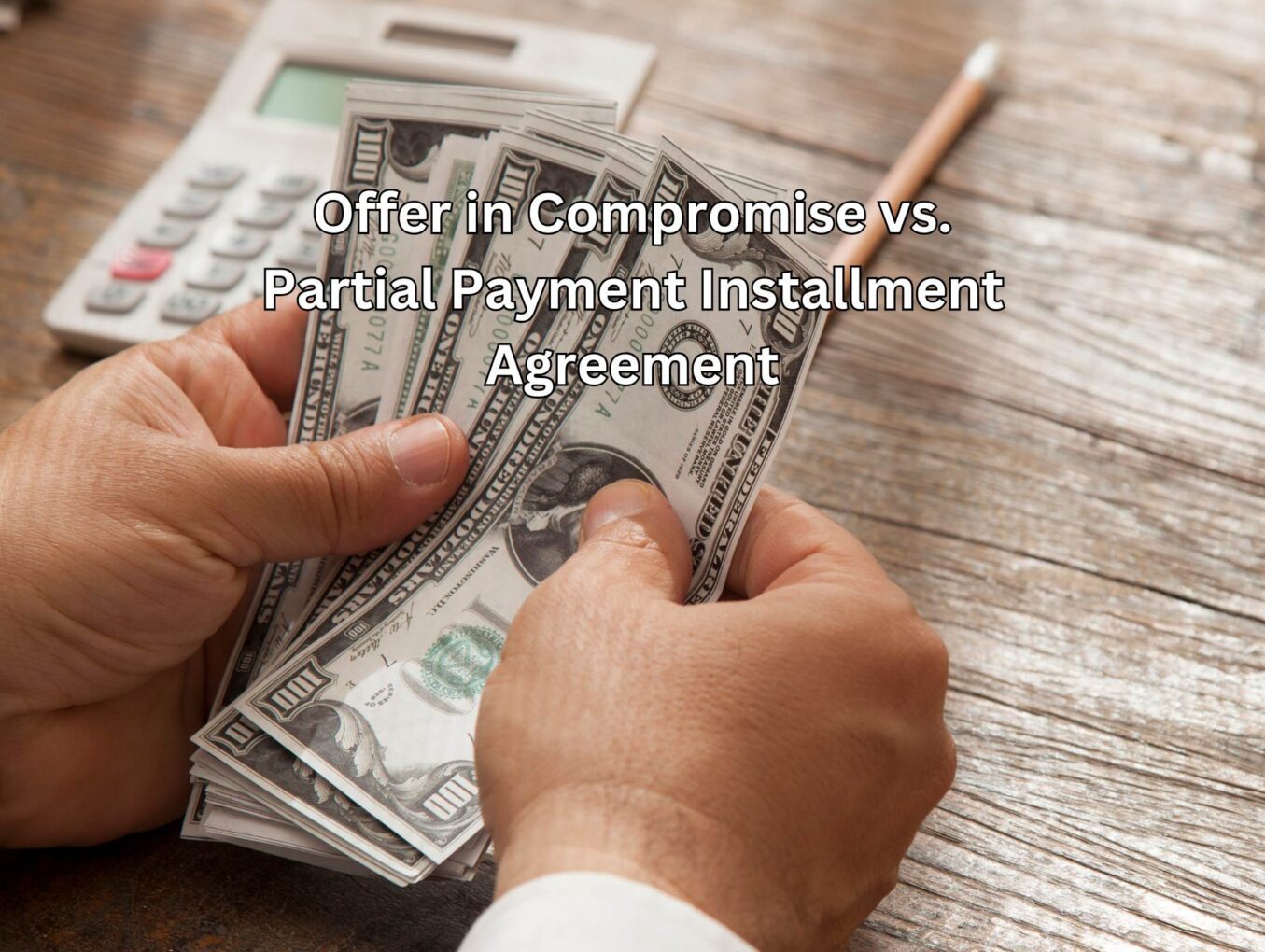What Is the Difference Between Offer in Compromise and Partial Payment Installment Agreement Tax Debt Relief Programs?
The IRS Offer in Compromise (OIC) program helps taxpayers resolve tax debt for a settlement amount that is a fraction of the full amount they owe.
For example, if you owe $25,000 in back taxes and use the OIC program to offer the IRS $15,000 based on your ability to pay, the IRS may approve a lump sum or periodic payment offer for your financial situation and reduce your debt.
Each taxpayer’s offer amount depends on individual circumstances, so two taxpayer’s who owe the same amount can have different OIC amounts accepted by the IRS.
A Partial Payment Installment Agreement (PPIA) is a structured monthly payment agreement for individuals with unpaid taxes who cannot afford to pay off the full amount within the IRS’s collection timeframe.
For example, if you owe $15,000 and can only afford $250 monthly PPIA payments for three years until the Collection Statute Expiration Date (CSED), you will pay off $9,000 of your tax debt.
The remaining $6,000 is then waived. The IRS will review your personal finances to determine the monthly PPIA amount you will pay until your CSED. How much less you will pay compared to what you owe depends on your financial situation and the time remaining to your CSED.
OIC vs. PPIA Process: What to Expect When Applying for Tax Settlement Programs
OIC Process
OIC Forms:
- Form 656: main OIC form
- Form 433-A OIC: Collection Information Statement for Individuals
- Form 433-B OIC: Collection Information Statement for Businesses
In addition to forms 656 and 433, the IRS may request other forms, such as Form 656-L, for offers based on Doubt as to Liability (DATL).
Taxpayers must also provide very specific financial details, including income, assets, expenses, and employment status documents.
All this information should support the claim of inability to pay the entire tax debt and the amount offered.
OIC Review:
The IRS review of an OIC application can take several months or longer. During the OIC review, a taxpayer can pay the IRS what they can afford and then the lower offer amount when it is approved.
Note that interest and penalty fees will continue to be added to the debt until it is fully paid even if the IRS approves a lower offer amount.
PPIA Process
PPIA Forms:
- Form 9465: main Installment Agreement Request form
- Form 433-A: Collection Information Statement for Individuals
- Form 433-B: Collection Information Statement for Businesses
In straightforward cases, Form 433-F is often used to resolve tax issues involving taxpayers who owe the IRS less than $250,000 or when a case is not assigned to a Revenue Officer.
Just like with an OIC, taxpayers must provide financial information about their income, assets, expenses, and other debts and liabilities.
In addition to financial instability, those requesting partial payment installment agreements must prove they cannot pay the entire tax debt within the IRS’s collection period.
PPIA Review:
The IRS reviews PPIA applications, verifies financial documents, and evaluates the partial payment amount for what it considers a taxpayer’s ability to pay. In most cases, a PPIA review is completed in one to three months.
OIC vs. PPIA Eligibility Criteria
To qualify for an OIC, taxpayers must be current with tax filings, not in bankruptcy, and have received a bill for at least one tax debt included in the offer.
Additionally, they must keep up with estimated tax payments, if applicable. Business proprietors must also be current with their federal tax deposits.
PPIA eligibility includes having a tax debt exceeding $10,000, access to little disposable income, and limited assets. Applicants should be up to date on tax filings, free from bankruptcy proceedings, and not be pursuing an active OIC.
PPIA candidates must also show they cannot pay off the entire tax debt before the CSED. In contrast, OIC applicants must only prove their inability to pay all back taxes.
OIC vs. PPIA Debt Reduction and Payment Terms: Can You Settle for Less Than You Owe?
The OIC program is specifically designed to allow taxpayers to settle tax debt for less than the full amount.
Offering to settle with the IRS for a reduced amount through an OIC requires the full settlement amount to be paid as either a lump sum in five or fewer months or a periodic payment within 24 months.
The PPIA program also lets taxpayers settle tax debt for less than they owe, but as mentioned earlier, how much less depends on both finances and time left to CSED expiration.
The CSED is typically 10 years from when the tax was originally assessed. With a PPIA, the IRS calculates the payments to be made every month until CSED. Once that time passes, the IRS cannot collect the remaining tax debt.
OIC vs. PPIA Payment Default
Notifications are sent to taxpayers who miss an OIC payment with a 60-day window for resolving defaults. For missed PPIA payments, the IRS sends either a CP523 notice or 2975 letter (intent to levy) that provides a 30-day window to address the default.
So, an OIC will give taxpayers a bit more time to make up missed payments. For both situations, if a taxpayer does not pay and defaults, it means the IRS can now collect the full amount originally owed (less payments made) instead of the lower OIC or PPIA amount.
Need more help? You can start online by answering 6 simple questions.
6 Simple Questions. Free Evaluation.

